|
Road Safety Issues
Advanced Driver Assistance Systems (ADAS)
There has been much discussion in recent years on the topic of autonomous vehicles; however, while these are under active development and even, in some cases, are on the road as limited test fleets, their full potential has yet to be exploited. Nevertheless, a number of the underlying technologies and sub-systems are making their way into the current vehicle fleet. Marketed as Advanced Driver Assistance Systems (ADAS), many current production vehicles are equipped with a variety of such high-tech systems.
Il y a eu beaucoup de discussions, ces dernières années, autour des véhicules autonomes. Toutefois, bien qu'ils sont actuellement en développement et, dans certains cas, soient soumis à des tests routiers, le potentiel des véhicules autonomes reste à exploiter. Il faut également reconnaître qu'un certain nombre de technologies a déjà fait son apparition dans le parc de véhicules. Commercialisés sous l'appellation ADAS (Advanced Driver Assistance Systems), les systèmes avancés d'aide à la conduite font partie intégrante de plusieurs véhicules de série.
Reference: Advanced Driver Assistance Systems (ADAS); German A; pp. 26-28; The Safety Network; Issue No. 4; 2019
|
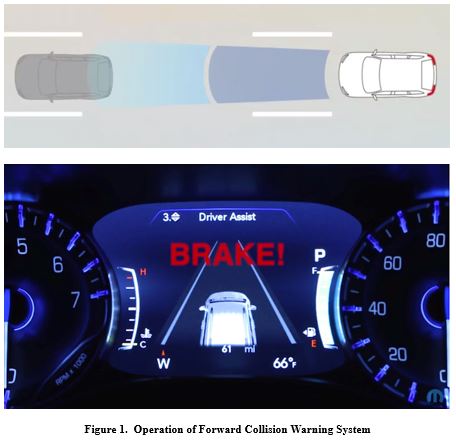
|
High-Tech Motor Vehicle Safety Systems
Sophisticated electronic sensing and control systems are increasingly being integrated into the motor vehicle fleet to provide drivers with advanced occupant protection and collision avoidance mechanisms. A project to develop a series of linked web pages outlining the major features of high-tech motor vehicle safety systems was undertaken on behalf of the Canadian Association of Road Safety Professionals. The major concepts and functions of the systems described are illustrated by appropriate diagrams and/or photographs. Links are provided to additional technical information, performance evaluations, and external web sites providing supplementary data. The project includes advanced occupant restraints (seat belt pretensioners, load limiters, advanced frontal air bags, side air bags and head curtains), active head restraints, anti-lock braking systems, brake assist, traction control systems, electronic stability control systems, event data recorders, night vision systems, adaptive cruise control, blind spot detection and backup warning systems. The resulting web pages provide useful information to the vehicle-buying public and will assist individuals to make informed choices for safety features that may only be available in certain makes and models and/or as optional equipment.
Reference: High-Tech Motor Vehicle Safety Systems; Kevin McClafferty and Alan German; Proceedings of the 18th Canadian Multidisciplinary Road Safety Conference; Whistler, British Columbia; June 8-11, 2008
|
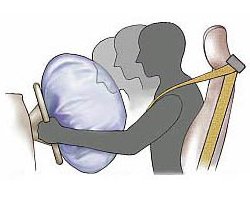
Image courtesy of Technology Associates
|
Event Data Recorders (EDR's)
The use of on-board electronic recorders in the aviation industry is well known. In the event of a crash, the recovery of in-flight recording systems (the so-called black boxes) is a priority for collision investigators, and the data obtained becomes an integral part of the crash reconstruction process. Less well known is the fact that event data recorders (EDR's) are present on most late-model cars and light trucks. These systems offer tremendous potential to traffic safety researchers, affording access to a wealth of new data, enabling better understanding of on-road traffic safety issues, and providing opportunities for the development of new and effective countermeasures.
Many modern air bag control systems have adopted electronic sensing systems where a vehicle-mounted accelerometer is used to monitor the crash pulse. A microprocessor analyzes the vehicle’s acceleration-time history and, based on pre-programmed decision logic, determines when air bag systems should be deployed. Using some of the computer memory present in such systems, manufacturers have been able to store certain data relating to collision events. Analysis of these data has provided a means to refine the algorithms used for deployment logic.
Many other systems on the vehicle utilize electronic technology. For example, engine management and emission control systems often use microprocessors, as do anti-lock braking and traction-control systems. As a result, manufacturers are moving to the use of computer-bus systems to facilitate the flow of required information around the vehicle. The ready availability of such signals provides for the capture of pre-collision data elements such as vehicle speed, engine rpm, throttle position, brake-switch status, and seat belt use.
Such objective collision-related data are invaluable to safety researchers wishing to identify specific factors which precipitate collisions, or to determine the nature and severity of crashes. Of course, the data will also be of interest to other parties including law enforcement personnel, members of the legal community, and insurance companies. These groups will no doubt wish to use recorded collision data to assign fault and support legal action, and so issues relating to the ownership, accessibility, and use of such data in individual cases will come into question.
Thus, there are potentially several conflicting issues related to the availability and use of data from on-board crash recorders. The question becomes if these devices are indeed black boxes to be used by "Big Brother" to monitor every aspect of driver actions or if they are the "silver bullet" that will provide the means to solve all of the extant traffic safety issues.
|
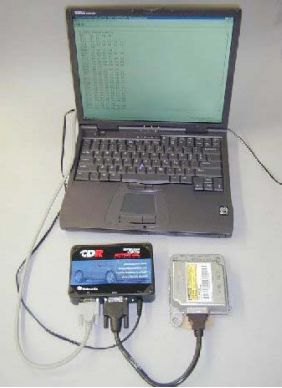
Black Boxes
or
Silver Bullets?
|
|
Selected Bibliography:
Event Data Recorders: A New Resource for Traffic Safety Research?; Alan German; The Safety Network; November, 2000
The Use of Event Data Recorders in the Analysis of Real-World Crashes; Alan German, Jean-Louis Comeau, Brian Monk, Kevin J. McClafferty, Paul F. Tiessen, and Joseph Chan; Proceedings of the Canadian Multidisciplinary Road Safety Conference XII; London, Ontario; June 10-13, 2001
A Study of Pre-Crash Events Using Information Retrieved from Event Data Recorders; Kevin McClafferty, Paul Tiessen, Michael Shkrum, Alan German, Jim White, Viliam Glazduri, Joseph Chan and Pella Deyell; Proceedings of the Canadian Multidisciplinary Road Safety Conference XIII; Banff, Alberta; June 8-11, 2003
Comparison of Crash Pulse Data from Motor Vehicle Event Data Recorders and Laboratory Instrumentation; Jean-Louis Comeau, Alan German and Donald Floyd; Proceedings of the Canadian Multidisciplinary Road Safety Conference XIV; Ottawa, Ontario; June 27-30, 2004
Crash Pulse Analysis using Event Data Recorders; Dalmotas DJ, German A and Comeau J-L; Proceedings of the Canadian Multidisciplinary Road Safety Conference XIX, Saskatoon, SK, June 8-10, 2009
Crash Pulse Data from Event Data Recorders in Rigid Barrier Tests; Comeau J-L, German A and Dalmotas D; Paper Number 11-0395; 22nd International Technical Conference on the Enhanced Safety of Vehicles; Washington, DC; June, 2011
The Use of Event Data Recorders in the Analysis of Unintended Acceleration Incidents; Lehouillier T, Holmes W and German A; Proceedings of the Canadian Multidisciplinary Road Safety Conference XXIII; Montreal, Quebec; May, 2013
Advanced Event Data Recorders; German A; The Safety Network; pp. 9-12; Issue 4, 2014
The Application of Event Data Recorders to Vehicle Safety Research; Comeau J-L, Holmes W, Monk B, Dalmotas DJ, German A, Schramm S, Thannhauser S and Good C; Proceedings of the 27th CARSP Conference; Toronto, ON; June 18-21, 2017
Recent Advances in EDR Technology; Comeau J-L and German A; The Safety Network; pp. 21-25; Issue No. 4; 2019
|
Frontal Air Bags
Air cushion restraint systems, commonly known as air bags, were initially introduced as supplementary restraint systems (SRS) meaning that they were nominally designed to provide a level of occupant protection over and above that offered by the available seat belt systems.
Typically, an in-vehicle accelerometer is used to monitor vehicle deceleration in the event of a crash and signal air bag deployment. A pyrotechnic gas generator rapidly inflates a cushion providing a shield against a driver contacting the steering wheel or a passenger striking the dashboard.
Early Canadian research showed that first-generation air bags had both low thresholds for deployment and overly-aggressive deployment characteristics. In severe crashes, air bags provided good head protection; however, in low severity collisions, the energy of the deploying air bag was often found to be the dominant factor in injury production. This was especially notable in a number of minor crashes where vehicle occupants were fatally injured, with the injury mechanism being attributed to adverse interaction with a deploying air
bag.
|
"In jurisdictions such as Canada which have high levels of seat belt usage, the vast majority of air bag
deployments in low speed collisions serve no useful purpose."
Dalmotas, Hurley and German, 1996
|
A combination of in-depth field investigations of air bag deployment crashes and in-laboratory crash testing using anthropomorphic test devices (crash test dummies) provided evidence for the need for a variety of countermeasures. These included the development and distribution of public safety information, the introduction of less aggressive second-generation (depowered) air bags, a national air bag deactivation programme for at-risk occupants, the development of "smart" air bag systems, and a range of testing procedures to assure the adequate collision performance of the new technologies.
|
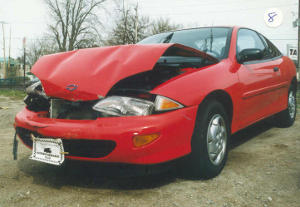
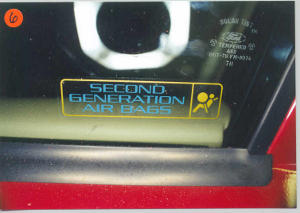
|
|
Selected Bibliography:
Real-World Collision Experience for Airbag Technology; German A, Dalmotas DJ, McClafferty KJ, and Nowak ES; Advances in Transportation Systems, Proc. CSME Forum 1996; Hamilton, Ontario; 1996
Supplemental Restraint Systems: Friend or Foe to Belted Occupants?; Dalmotas DJ, Hurley RM and German A; Proc. 40th. AAAM Conf.; pp. 63-75; Vancouver BC; 1996
Paper is available from the Association for the Advancement of Automotive Medicine
Air Bag Induced Fatalities in Canada; German A, Dalmotas D, Tylko S, Comeau J-L and Monk B; Proc. CMRSC-XIII; Banff, Alberta; June 8-11, 2003
|
Seat Belts on School Buses
School bus transportation is incredibly safe, but does that mean seat belts are not necessary on school buses? Dr. Alan German, Chief of Collision Investigations in the Road Safety Directorate at Transport Canada, led a discussion surrounding seat belts and school buses at the Annual Conference of the Manitoba Safety Council in Winnipeg on December 6, 2001. Participants in the discussion included school board officials from various regions of Manitoba. A report of the presentation and the ensuing discussion appeared in
Manitoba Child Injury Prevention News; Vol 3 No 3; Winter 2002.
|
 |
Road Safety is Everyone's Responsibility
Are you part of the problem - or part of the solution?
|
http://www.roadsafetyresearch.ca
|